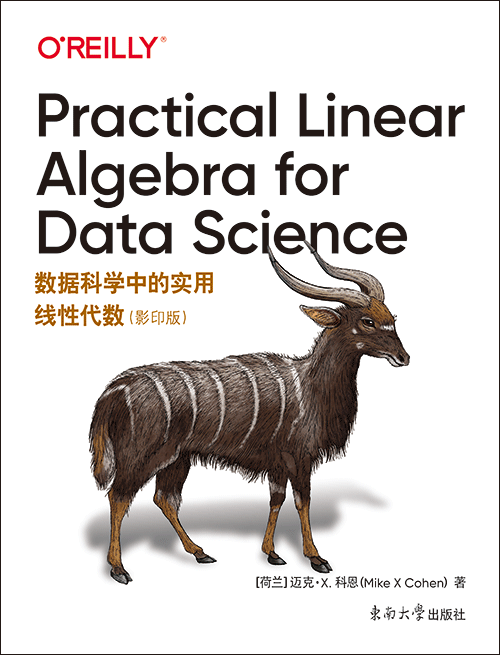数据科学中的实用线性代数(影印版)
出版时间:2023年03月
页数:311
“对于新手来说,线性代数的抽象本质使他们难以看到这门学科有什么用处,尽管其应用十分广泛。这本书很好地讲授了线性代数的实际应用以及来龙去脉。”
——Thomas Nield
Nield Consulting Group,Essential Math for Data Science和Getting Started with SQL作者
如果你想从事计算或技术领域的工作,理解线性代数是少不了的。线性代数的研究对象是矩阵及其运算,是几乎所有计算机算法和分析的数学基础。但它在几十年前的教科书中的呈现方式与专业人员如今用来解决现实世界问题的方式有很大不同。
这本来自Mike X Cohen的实用指南讲授了以Python实现的线性代数的核心概念,包括如何在数据科学、机器学习、深度学习、计算模拟和生物医学数据处理应用中使用它们。有了这本书,理解、实现和适应繁多的现代分析方法和算法将不再是问题。
本书适用于使用计算机技术和算法的业界人士和学生,内容包括:
● 向量和矩阵的讲解和应用
● 矩阵运算(各种矩阵乘法和变换)
● 独立性、秩、转置
● 线性代数中使用的重要分解(包括LU和QR)
● 特征分解和奇异值分解
● 最小二乘模型拟合和主成分分析等应用
——Thomas Nield
Nield Consulting Group,Essential Math for Data Science和Getting Started with SQL作者
如果你想从事计算或技术领域的工作,理解线性代数是少不了的。线性代数的研究对象是矩阵及其运算,是几乎所有计算机算法和分析的数学基础。但它在几十年前的教科书中的呈现方式与专业人员如今用来解决现实世界问题的方式有很大不同。
这本来自Mike X Cohen的实用指南讲授了以Python实现的线性代数的核心概念,包括如何在数据科学、机器学习、深度学习、计算模拟和生物医学数据处理应用中使用它们。有了这本书,理解、实现和适应繁多的现代分析方法和算法将不再是问题。
本书适用于使用计算机技术和算法的业界人士和学生,内容包括:
● 向量和矩阵的讲解和应用
● 矩阵运算(各种矩阵乘法和变换)
● 独立性、秩、转置
● 线性代数中使用的重要分解(包括LU和QR)
● 特征分解和奇异值分解
● 最小二乘模型拟合和主成分分析等应用
- Preface
- 1. Introduction
- What Is Linear Algebra and Why Learn It?
- About This Book
- Prerequisites
- Mathematical Proofs Versus Intuition from Coding
- Code, Printed in the Book and Downloadable Online
- Code Exercises
- How to Use This Book (for Teachers and Self Learners)
- 2. Vectors, Part 1
- Creating and Visualizing Vectors in NumPy
- Operations on Vectors
- Vector Magnitude and Unit Vectors
- The Vector Dot Product
- Other Vector Multiplications
- Orthogonal Vector Decomposition
- Summary
- Code Exercises
- 3. Vectors, Part 2
- Vector Sets
- Linear Weighted Combination
- Linear Independence
- Subspace and Span
- Basis
- Summary
- Code Exercises
- 4. Vector Applications
- Correlation and Cosine Similarity
- Time Series Filtering and Feature Detection
- k-Means Clustering
- Code Exercises
- 5. Matrices, Part 1
- Creating and Visualizing Matrices in NumPy
- Matrix Math: Addition, Scalar Multiplication, Hadamard Multiplication
- Standard Matrix Multiplication
- Matrix Operations: Transpose
- Matrix Operations: LIVE EVIL (Order of Operations)
- Symmetric Matrices
- Summary
- Code Exercises
- 6. Matrices, Part 2
- Matrix Norms
- Matrix Spaces (Column, Row, Nulls)
- Rank
- Rank Applications
- Determinant
- Summary
- Code Exercises
- 7. Matrix Applications
- Multivariate Data Covariance Matrices
- Geometric Transformations via Matrix-Vector Multiplication
- Image Feature Detection
- Summary
- Code Exercises
- 8. Matrix Inverse
- The Matrix Inverse
- Types of Inverses and Conditions for Invertibility
- Computing the Inverse
- The Inverse Is Unique
- Moore-Penrose Pseudoinverse
- Numerical Stability of the Inverse
- Geometric Interpretation of the Inverse
- Summary
- Code Exercises
- 9. Orthogonal Matrices and QR Decomposition
- Orthogonal Matrices
- Gram-Schmidt
- QR Decomposition
- Summary
- Code Exercises
- 10. Row Reduction and LU Decomposition
- Systems of Equations
- Row Reduction
- LU Decomposition
- Summary
- Code Exercises
- 11. General Linear Models and Least Squares
- General Linear Models
- Solving GLMs
- GLM in a Simple Example
- Least Squares via QR
- Summary
- Code Exercises
- 12. Least Squares Applications
- Predicting Bike Rentals Based on Weather
- Polynomial Regression
- Grid Search to Find Model Parameters
- Summary
- Code Exercises
- 13. Eigendecomposition
- Interpretations of Eigenvalues and Eigenvectors
- Finding Eigenvalues
- Finding Eigenvectors
- Diagonalizing a Square Matrix
- The Special Awesomeness of Symmetric Matrices
- Eigendecomposition of Singular Matrices
- Quadratic Form, Definiteness, and Eigenvalues
- Generalized Eigendecomposition
- Summary
- Code Exercises
- 14. Singular Value Decomposition
- The Big Picture of the SVD
- SVD in Python
- SVD and Rank-1 “Layers” of a Matrix
- SVD from EIG
- SVD and the MP Pseudoinverse
- Summary
- Code Exercises
- 15. Eigendecomposition and SVD Applications
- PCA Using Eigendecomposition and SVD
- Linear Discriminant Analysis
- Low-Rank Approximations via SVD
- Summary
- Exercises
- 16. Python Tutorial
- Why Python, and What Are the Alternatives?
- IDEs (Interactive Development Environments)
- Using Python Locally and Online
- Variables
- Functions
- Visualization
- Translating Formulas to Code
- Print Formatting and F-Strings
- Control Flow
- Measuring Computation Time
- Getting Help and Learning More
- Summary
- Index
书名:数据科学中的实用线性代数(影印版)
作者:Mike X Cohen 著
国内出版社:东南大学出版社
出版时间:2023年03月
页数:311
书号:978-7-5766-0588-4
原版书书名:Practical Linear Algebra for Data Science
原版书出版商:O'Reilly Media
The animal on the cover of Practical Linear Algebra for Data Science is a nays antelope, also known as the lowland nyala or simply nyala (Tragelaphus angasii). Female and juvenile nyalas are typically a light reddish-brown, while adult males have a dark brown or even grayish coat. Both males and females have white stripes along the body and white spots on the flank. Males have spiral-shaped horns that can grow up to 33 inches long, and their coats are much shaggier, with a long fringe hanging from their throats to their hindquarters and a mane of thick black hair along their spines. Females weigh about 130 pounds, while males can weigh as much as 275 pounds.
Nyalas are native to the woodlands of southeastern Africa, with a range that includes Malawi, Mozambique, South Africa, Eswatini, Zambia, and Zimbabwe. They are shy creatures, preferring to graze in the early morning, late afternoon, or nighttime, and spending most of the hot part of the day resting among cover. Nyalas form loose herds of up to ten animals, though older males are solitary. They are not territorial, though males will fight over dominance during mating.
Nyalas are considered a species of least concern, though cattle grazing, agriculture, and habitat loss pose a threat to them.
Nyalas are native to the woodlands of southeastern Africa, with a range that includes Malawi, Mozambique, South Africa, Eswatini, Zambia, and Zimbabwe. They are shy creatures, preferring to graze in the early morning, late afternoon, or nighttime, and spending most of the hot part of the day resting among cover. Nyalas form loose herds of up to ten animals, though older males are solitary. They are not territorial, though males will fight over dominance during mating.
Nyalas are considered a species of least concern, though cattle grazing, agriculture, and habitat loss pose a threat to them.
购买选项
